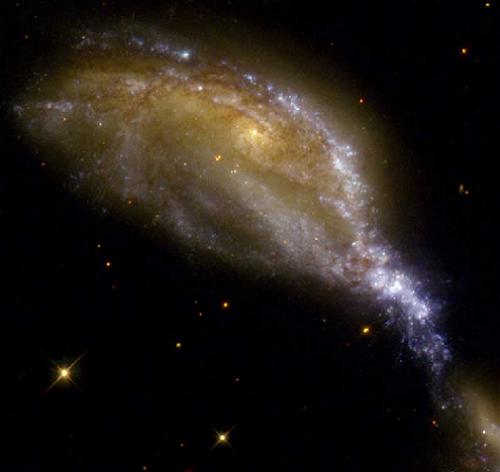It turns out that our universe experiences fewer collisions between galaxies than previously thought. This was learned by a researcher from the Australian National University [ANU] based on an analysis of information received from the Hubble Space Telescope

It turns out that our universe experiences fewer collisions between galaxies than previously thought. This was learned by a researcher from the Australian National University [ANU] based on the analysis of information received from the Hubble Space Telescope.
Astronomer Dr. Alistair Graham, from the Research School of Astronomy and Astrophysics at the Australian National University, analyzed data from a number of galaxies located about 100 million light years away, and discovered that the number of violent encounters between large galaxies is about a tenth of the number previously assumed.
Although theoretical models predicted that the number of collisions that occurred in the evolution of the universe was relatively small, Dr. Graham's observations are the first to prove these theories.
"The new result is perfectly consistent with current models of the hierarchical structure of our universe," said Dr. Graham, "in galactic terms, things look a little more certain - out there."
For years, astronomers have known the term collision as combining two galaxies to form one much more massive galaxy. An effect seen in the newly formed galaxies, at least in the largest of them - is a lack of stars in their center, a phenomenon that is believed to occur due to the damage created during the merger of the supermassive black holes in the two smaller galaxies during the merger of the galaxies.
In any case, instead of needing a number of colliding factors in order to "clean" the stars from the core of the galaxy, Dr. Graham showed that a collision between only two galaxies would be sufficient for this purpose.
Using the Hubble Space Telescope's second wide-field planetary camera, Dr. Graham was able to study galaxies at a distance of one hundred million light years, whose cores were not emptied of stars, thus providing important and in-depth information about the distribution of stars in galaxies before massive collisions with other galaxies. By taking into account the overall galactic structure, Graham could more accurately measure the empty cores of other galaxies.
The result: the mass of the missing stars in the centers of the galaxies is equal to and slightly exceeds the mass of the black hole in their center. galaxies.
"If there were about ten mergers, we would find a deficit 10 times greater than the mass of the black hole. Many galaxies have large central black holes at their centers, but they have not been emptied of stars. Therefore, probably not every black hole is formed by swallowing its neighboring stars. Instead, we see the destroyed cores of galaxies only after the merger of two 'wrecking balls' (colliding galaxies).
Although small satellite galaxies were captured by the Milky Way galaxy (where we are), it did not undergo a critical change. If this were to happen, the plane of its disk (visible in the night sky from a dark place as a gray band of stars) would break up. Such a fate is expected in about three billion years, when the Milky Way galaxy will collide with its neighboring spiral galaxy, Andromeda.
This research was guided during Dr. Graham's time at the University of Florida, and was funded by NASA, as a grant from the Space Telescope Science Institute in Baltimore. Dr. Graham's research will appear in the September 20 issue of "Astrophysical Journal Letters".
